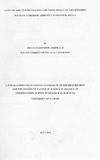| dc.description.abstract | This study was conducted in Kitenden Wildlife Corridor (KWC), within Amboseli Ecosystem between October 2011 and January 2012. The research sought information to enhance conservation and management of KWC. The objective was to determine the ecological viability of KWC to wildlife movement between Amboseli National Park (ANP) in Kenya and Kilimanjaro National Park (KNP) in Tanzania. Data on land use and tenure were obtained through questionnaire administration and secondary sources. Vegetation and animal were sampled in the five following habitats Licium europeanum grassland, Acacia torti/is bushland, Acacia mellifera bushland, Commiphora shimperi bushland and farmland.
Herbaceous vegetation was sampled using a 2m by 2m quadrat and a Disc Pasture Meter (DPM). PCQ and belt transect methods was use to sample woody plants. Animal count was done using sample foot count. This study found that people in KWC were mostly engaged in mixed farming (livestock and cultivation), and they were more people cultivating than those raising livestock. Initially being a community land, it was found that 30.12% of the study area was privately owned while 69.88% was still under community group ranch. Woody species mean densities ranged between 56.4ᄆ13.23 treeslha estimated in Commiphora shimperi bushland and 15.35ᄆ5.98 treeslha estimated in Licium europeanum grassland. Woody species density differed significantly (F4. 52 = 3.576, p<O.05) among habitats.
The study area was dominated by poor quality grass for grazers, and increaser I with (19%) cover was highest and forbs the lowest with (7%). There was a significant difference in mean cover among the four herbaceous vegetation categories (decreaser, Increaser I, Increaser II, and Forb) (F3, 524 = 29.015, p<0.05). Mean wild herbivores population density ranged between 19.23ᄆ4.43 animals/krrr' estimated in Commiphora schimperi bushland and 4.59ᄆ0.45 animalslkm2 estimated in Farmland. No significant difference (F4,38 = 1.841, p>O.05)was found among the five habitats. Human activities in the KWC are causing degradation and constriction of wildlife habitat and pose heavy threats on the viability of the corridor for wildlife movement.
The study recommended that conservation organizations shoulg lease the KWC from land owners to prevent further spreading of cultivation in the corridor, and pasture management strategies should be put in place for example by reducing the grazing stock and re-seeding the corridor with decreaser species, and an exclusive wildlife use zone delimitated . | en_US |

